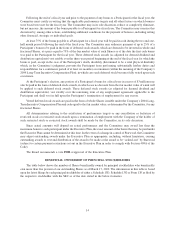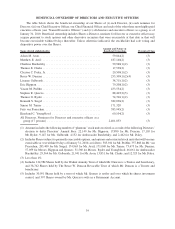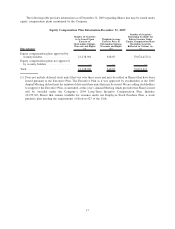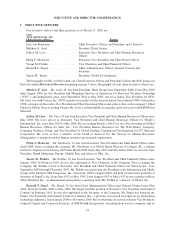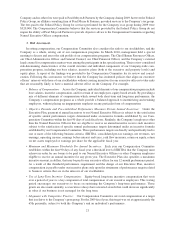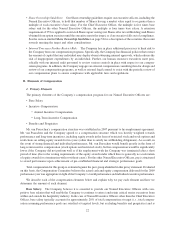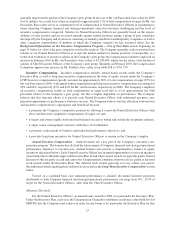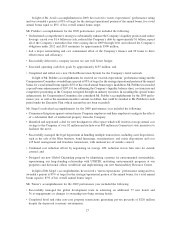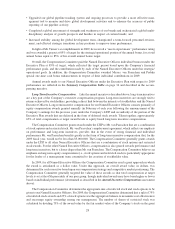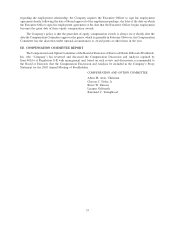Starwood 2009 Annual Report Download - page 32
Download and view the complete annual report
Please find page 32 of the 2009 Starwood annual report below. You can navigate through the pages in the report by either clicking on the pages listed below, or by using the keyword search tool below to find specific information within the annual report.generally targeted at the median of the Company’s peer group. In the case of Mr. van Paasschen, base salary for 2009
was $1 million. As a result, base salary accounted for approximately 13% of total compensation at target for Mr. van
Paasschen. Base salary serves as a minimum level of compensation to Named Executive Officers in circumstances
when achieving Company financial and strategic/operational objectives becomes challenging and the level of
incentive compensation is impacted. Salaries for Named Executive Officers are generally based on the respon-
sibilities of each position and are reviewed annually against similar positions among a group of peer companies
developed by the Company and its advisors consisting of similarly-sized hotel and hospitality companies as well as
other companies representative of markets in which the Company competes for key executive talent. See the
Background Information on the Executive Compensation Program — Use of Peer Data section beginning on
page 31 below for a list of the peer companies used in this analysis. The Company generally seeks to position base
salaries of our Named Executive Officers at or near the market median for similar positions. Consequently, as a
result of an evaluation of executive salaries in the Company’s peer group, the compensation committee approved an
increase in February 2010 in Mr. van Paasschen’s base salary to $1,250,000, which sets his salary at the median of
salaries of Chief Executive Officers of the Company’s peer group. Similarly, in February 2010, the Compensation
Committee approved an increase in Mr. Prabhu’s base salary from $640,658 to $751,750.
Incentive Compensation. Incentive compensation includes annual bonus awards under the Company’s
Executive Plan as well as long-term incentive compensation in the form of equity awards under the Company’s
LTIP. Incentive compensation typically accounts for approximately 80% of total compensation at target (87% for
Mr. van Paasschen in 2009), with annual bonus compensation and long-term incentive compensation accounting for
20% and 60%, respectively (25% and 62% for Mr. van Paasschen, respectively, in 2009). The Company’s emphasis
on incentive compensation results in total compensation at target level that is set at approximately the 65th
percentile relative to the Company’s peer group, but that is highly dependent on performance. The Company
believes that this structure allows it to provide each Named Executive Officer with substantial incentive com-
pensation opportunities if performance objectives are met. The Company believes that the allocation between base
and incentive compensation is appropriate and beneficial because:
• it promotes the Company’s competitive position by allowing it to provide Named Executive Officers with
above-median total competitive compensation if targets are met;
• it targets and attracts highly motivated and talented executives within and outside the hospitality industry;
• it aligns senior management’s interests with those of stockholders;
• it promotes achievement of business and individual performance objectives; and
• it provides long-term incentives for Named Executive Officers to remain in the Company’s employ.
Annual Incentive Compensation. Annual bonuses are a key part of the Company’s executive com-
pensation program. The bonuses directly link the achievement of Company financial and strategic/operational
performance objectives to executive pay. Annual bonuses also provide a complementary balance to equity
incentives (discussed below). Each Named Executive Officer has an annual opportunity to receive an incentive
award under the stockholder-approved Executive Plan. If and when earned, awards are typically paid to Named
Executive Officers partly in cash and, unless the Compensation Committee otherwise elects, partly as deferred
stock awards (under the Executive Plan). The deferred stock awards generally vest over a three-year period.
See additional detail regarding these deferred stock awards in the Long-Term Incentive Compensation section
below.
Viewed on a combined basis once minimum performance is attained, the annual incentive payments
attributable to both Company financial and strategic/operational performance can range from 0% - 275% of
target for the Named Executive Officers, other than the Chief Executive Officer.
Minimum Threshold.
For the Named Executive Officers, an annual bonus award for 2009 was paid under the Executive Plan.
Under the Executive Plan, each year, the Compensation Committee establishes in advance a threshold level of
EBITDA that the Company must achieve in order for any bonus to be paid under the Executive Plan for that
23



